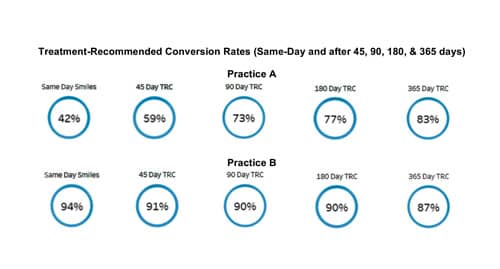In prior editions of Inside The Numbers, I’ve covered the importance of clean conversion metrics that restrict your eligible consults to those with treatment-recommended patients (Treatment-Recommended Conversion rate or TRC). That eliminates the contamination of inflows and outflows of recall patients. Some practices try to replicate this with manual reporting, but end up introducing even more error. A verbal ‘YES’ is often counted as a start, but few TCs go back and deduct prior month starts when there are contract cancellations, so their conversion numbers are often overestimated. Clean data is critical.
As we continue to refine our analytics, we see that just as important as what you are counting is when you count it, and when you look at it. For example, most Practice Management Systems display Case Acceptance, which commonly tags starts to the month of the clinical start. This obscures visibility to the effectiveness of your TC at the point of attack, and their ability to follow up effectively. In fact, in cases of TC turnover, the new TC often gets credit for a start they never pitched. That’s why we tag conversions back to the month of the treatment-recommended consult. We also find that time trends can tell you interesting stories. We have always displayed our proprietary TRC rate metric. However, we are now finding that one conversion rate number doesn’t tell the full story, and that looking at multiple conversion snapshots over time identifies trends and reveals a fuller picture. Take a look at two high-performing practices in the chart above with similar overall conversion rates (rightmost metric). With a single number you wouldn’t draw any conclusions about what is different and what each team should work on to improve conversion. However, by looking at this timeline, you can see that they clearly have distinct stories that would otherwise be blurred or lost. Practice A has a conventional snapshot trend. They have a fairly good Same-Day Contract rate of 42%, but the majority of patients start over time after the consult. Naturally, within 45 days of the consult, the conversion rate is up but still under 60%. Due to good follow-up, they see their TRC climb over time to a rate of 83%, their true conversion rate. With this level of visibility, they can clearly see that to increase conversion rate they should work to increase same-day contracts, as their follow-up protocol is solid. Practice B, on the other hand, has a 94% Same-Day Contract Rate. They work hard to get commitment while the iron is hot, even if they end up scheduling the start out some time. Their 45-Day TRC is high as expected, but interestingly drops a bit due to some of these closes changing their minds after signing. Practice B’s 365-Day TRC rate is higher than Practice A, proving that same-day focus yields better results, but this view reveals the risk & reward of their carpe diem culture. It gives them a sightline on what to work on, in this case post-signing patient nurturing to cement the relationship.
The key here is the metric: with a standard single Case Acceptance metric, you lose these trends and storylines. Ultimately what you really want is a metric that is accurate in both real-time and over time, and one that helps you to identify areas of opportunity. In this case, you want a metric that registers only actual confirmed starts, and into the time period when the case was pitched. That is the truest measure of how your consult room is performing. By looking at a cleaner past, you can better understand and predict your likely future. OP
About Inside the Numbers: Answers to questions submitted to Inside the Numbers are based on data collected by OrthoFi™, and presented by CEO David Ternan. The data pulls from 250,000+ consults and over 200,000 patient starts in over 250 practices, including patient demographics and preferences, risk profile, and payment performance on over $200 million in receivables. Inside the Numbers aims to help you make informed decisions about patient financing and to dispel myths that can hinder growth.
Submit your questions to Inside the Numbers at [email protected].












